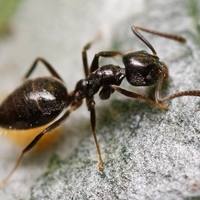How to Identify Odorous House Ants
If the ants are about 1/8″ long and look like they have a stinger on their back end, they might be Asian needle ants. If the ants are up to half an inch long, they may be black carpenter ants. If they’re in great number and extremely small, they might be Argentine ants, which can only be identified via microscope. If the ants are red and located in mounds of soil or dirt outside, then they are probably fire ants, and you should probably stay away because they can sting!
It is very important to know which species of ant you have encountered since their habits and food preferences vary greatly.
Ants are now among the most important pests both residentially and commercially.
This is due to their mere presence, as they are an overwhelming nuisance pest.
 Where Do Odorous House Ants Come From?
Where Do Odorous House Ants Come From?
In Raleigh, Charlotte and Wilmington, we are really living in the odorous house ant’s neighborhood. This ant is a SEVERE pest in the southern United States and is our number one ant pest. In areas of heavy infestation, it may be found in practically every home.
Odorous house ant colonies may contain up to 100,000 ants and MANY QUEENS. Super colonies may exist where food, water, and brood are exchanged between satellite locations.
Indoors, odorous house ants nest in wall voids, especially around hot water pipes and heaters and in crevices around sinks and cupboards.
Outdoors, nests are often found in soil, usually under objects. Odorous house ants are most likely to enter buildings when colonies become very large and natural food and water sources become scarce and when climate conditions become extreme (drought or heavy rains).
This pest seeks out a favorable habitat, especially plants that excrete honeydew. New colonies moving in are continually attracted to these sites and will re-infest.
Where do you See Odorous House Ants?
They can be seen almost anywhere in the home or structure. Usually, they are sighted first in the kitchen, bathrooms, or in commercial accounts in the break room areas. The odorous house ant can be anywhere there is a sweet food source, like sodas that might have been spilled, sweet cereals, candy, cakes, hummingbird feeders, etc.
Feeding Preferences of Odorous House Ants
Indoors, odorous house ants prefer sweets during most of the warm season. They will eat high-protein foods and greasy meats and cheeses as dictated by colony requirements. Outdoors, they feed on honeydew, plant secretions and sometimes seeds and insects.
Do-it-yourself ways to reduce the conditions that harbor and attract odorous house ants:
- Remove leaf clutter near structure
- Remove brush piles from structure
- Reduce mulch to 2 inches or less
- Seal gaps around doors and windows
- Repair foundation cracks
- Repair moisture-damaged wood inside and outside structure
- Clean gutters and downspouts of debris
- Clean garbage cans
- Move garbage cans 25 feet from structure
- Clean all pet food dishes and remove spilled pet food
- Repair all leaks in structure
- Seek professional assistance and a pest prevention plan
Economy Exterminators’ Pest Control Solutions program uses the 4-step approach to solve your odorous house ant pest problem:
- Our 1st step is the inspection of the property by a customer service specialist. It is very important to know the species involved and the severity of the pest problem. This is especially true with this pest since this pest has adapted to our urban environment so well. There are many areas that our inspectors know to look and identify as areas that need to be treated to give the best results.
- The 2nd step would be the initial treatment by a customer service specialist of all areas that the inspection revealed as critical areas. Economy Exterminators uses the newest and most effective materials to solve this pest problem quickly for you. Usual critical areas would be the kitchen, storage areas, crawlspaces, drains and garages. On the outside, special attention will be applied to all the windows, doors, eaves and the foundations. Special time and effort will be necessary in locating ant trails and nests.
- The 3rd step is a 37-point inspection of your property to identify areas on your property that give easy access of the odorous house ants to your property – by either direct access (cracks in the foundation) or by eliminating harborages – (mulch and leaves) or food sources that would be attractive to this type of ant.
- The 4th step would be an ongoing maintenance program for the next generation. New infestations will be moving on your property from the adjoining property. Our exclusive Pest Control Solutions program is designed to prevent the next generation of odorous ants for clients in the Raleigh, Charlotte and Wilmington, NC areas.

 Where Do Odorous House Ants Come From?
Where Do Odorous House Ants Come From?


